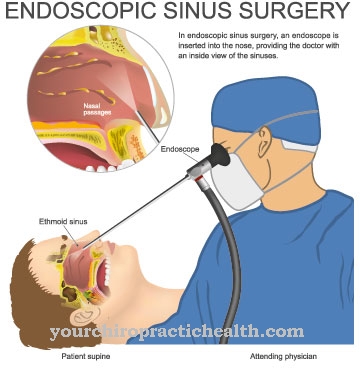A Mold allergy is an allergic reaction to mold spores. These molds usually appear in damp apartments or houses, but they can also be found in old food or textiles (e.g. curtains). A successful treatment against this form of allergy is only possible if the living space is completely renovated and freed from mold.
What is a mold allergy?

The Mold allergy belongs to the sphere of action of the house dust allergy and can be one of its triggers. There is an allergic reaction in humans to the spores of mold, which are found in small quantities in almost every household.
However, a mold allergy only occurs when there is enough mold in the apartment and the human immune system is sensitized to it.
causes
A Mold allergy assumes that the patient is exposed to mold for a long time. The most common types are Aspergillus, Alternaria, and Cladosporium. Damp apartments with poor insulation or long-term mold problems are particularly dangerous. If the patient is exposed to the mold spores for a longer period of time, the immune system can become sensitized to the spores and typical allergenic symptoms occur.
Runny noses and frequent sneezing as well as reddened mucous membranes are among the most common symptoms; in particularly severe cases, asthmatic attacks even occur, which lead to hospitalization. However, the mold allergy can also be present from birth and show up as soon as serious problems caused by mold appear in a building.
Symptoms, ailments & signs
Many people suffer from the symptoms of a mold allergy due to undetected mold exposure. Since the symptoms are relatively common and unspecific symptoms such as watery, burning or itchy or burning eyes, frequent sneezing, a stuffy nose, chronic runny nose and coughing, these symptoms are often not correctly interpreted. In the long run, this can lead to further complaints such as asthma-like whistling when coughing or blocked sinuses.
The appearance of the symptoms depends on the type of mold to which the affected person is reacting. Once there are sources of mold in the living space, it is difficult to completely remove them. In the case of allergic reactions to the mold spores, those affected usually have seasonal or year-round symptoms - especially in the cold season when the mold spreads unnoticed. The allergic reaction is caused by mold spores in the air.
In addition to symptoms in the respiratory tract and on the face, mold-related complaints in the gastrointestinal tract can also occur with a mold allergy. These are triggered by food contaminated with mold or fermented. Mold allergy sufferers must avoid foods that have been produced with starter cultures and refiners or that have been produced with the aid of metabolic products of the mold.
In severe cases of mold allergy, nettle rash, allergic asthma, migraine attacks or, in extreme cases, anaphylactic shock can occur.
Course of disease
At a Mold allergy The first symptoms occur shortly after contact with mold spores, which are constant and can at most worsen if the patient comes into contact with other spores. Symptoms of the disease show up where it occurred within the first seconds or minutes of exposure. Since the fungal spores are usually carried through the air, the mold allergy makes itself immediately noticeable through runny nose, sneezing, shortness of breath or asthmatic attacks.
The sequence of these symptoms can increase: at first only the slightest signs are shown, but the longer the contact lasts, the more severe they become.The severity of the symptoms depends on the one hand on the amount of spores to which the patient is exposed, but also on the length of time over which the contamination of the living space with dangerous molds has already extended.
Some patients also experience reddening of the skin, which may be itchy or painful when the skin comes into contact with the mold spores. Mold allergy is not the only disease that can result from mold - over time, symptoms can develop into chronic conditions.
Complications
A mold allergy carries a significant risk of various complications. This is especially true if the allergen exposure is permanent and no early therapy is given. So it is possible that there is a so-called change of floor and the complaints shift from the upper to the lower airways. The consequence of this is allergic asthma.
The respiratory system of the affected person in particular often suffers from a mold allergy. The disease can lead to sequelae such as allergic rhinitis (allergic rhinitis), bronchial asthma (type I allergy), chronic inflammation of the paranasal sinuses (sinusitis) and simultaneous inflammation of the nasal mucosa and sinus lining, which doctors call rhinosinusitis.
Allergic bronchopulmonary aspergillosis (ABPA), which is caused by molds from the Aspergillus genus, is also possible. Furthermore, the airways can be affected by tracheitis allergica. This is an inflammation of the windpipe that leads to severe coughing fits.
Consequential diseases caused by a mold allergy are also possible on the skin and subcutaneous tissue. These include nettle rash (urticaria), which is associated with edematous efflorescences, and allergic eczema, in which the skin changes inflammatory.
Other conceivable complications of a mold allergy are allergic gastroenteritis, which manifests itself in a bloated stomach (meteorism) and diarrhea, as well as an anaphylactic reaction. People who suffer from an immune deficiency such as AIDS or who take immunosuppressants are considered to be particularly at risk for mold-related diseases.
When should you go to the doctor?
People whose home or work is affected by mold should have their health checked by a doctor. In the case of strong mold formation, a health check is generally advisable so that no long-term consequences or impairments develop. In the event of an urge to sneeze, a blocked nose or irregular breathing, research into the cause of the symptoms is required. If there is an increase in symptoms or if they persist for several weeks, action is required.
Noises while breathing, headaches or migraines are further signs of health problems. A visit to the doctor is advisable so that a diagnosis can be made. Redness of the eyes, itching or a general feeling of illness should be examined and treated. In particularly severe cases, an ambulance service is required.
If an anaphylactic shock occurs, an emergency doctor must be alerted and first aid measures must be used. Some patients may develop a sharp increase in symptoms within a short period of time. This is to be understood as a warning signal from the organism and requires immediate action. Severe swellings, shortness of breath or impaired consciousness must be treated by a doctor as quickly as possible.
Those affected who suffer from a gradual increase in symptoms should consult a doctor as soon as they experience a decrease in their performance. Sleep disorders or a general malaise should also be presented to a doctor.
Treatment & Therapy
The only correct and meaningful treatment of the Mold allergy is to keep the patient's living space free from mold. Before doing this, however, a diagnosis must be made as to whether it is actually a mold allergy - this is done by means of an allergy test that can be carried out by the family doctor. The source of mold must then be located in the living room and removed.
Occasionally there are damp walls or window joints, sometimes the allergy is also associated with the patient's lifestyle. Indoor plants, for example, are not conducive to a mold allergy as the earth can occasionally grow mold. Patients with a mold allergy should never leave kitchen waste lying around, as this also promotes the occurrence of allergenic symptoms.
In order to continue to counteract the occurrence of the allergy in the future, the main treatment and prevention must be the proper cleaning of the refrigerator and all other parts of the facility where mold can develop.
Aftercare
Mold allergy is a disease in which follow-up care and prevention go hand in hand. Follow-up care can be discussed with the allergist, but also with the family doctor. It is important to consciously avoid exposure to the allergen. There are different measures for this.
In the home, mold growth can often be prevented through consistent ventilation. This is particularly important for damp rooms such as the bathroom, but also for the bedroom in terms of relaxed and healthy sleep.
However, food with mold must also be avoided by allergy sufferers. It should be noted here that fruit with a high moisture content (e.g. grapes) has a particular tendency to mold and that this cannot always be recognized immediately. Food should therefore be stored in a dry place and carefully washed before consumption.
Mold allergy sufferers need fresh air so that the stressed lungs and bronchi can regenerate sustainably. Walks are particularly helpful here. Staying in the high mountains or at the lake on vacation can particularly support regeneration in this context.
Aftercare can also include a stay at a spa especially for the needs of allergy sufferers. Breathing exercises can complement aftercare. These are learned in physiotherapy and practiced at home in everyday life. Pranayama, the breathing exercises from yoga, are also used for relaxation.
You can do that yourself
The mold allergy offers two starting points with regard to self-help in everyday life: on the one hand in the area of targeted prevention, on the other hand in the area of acute disease. Both are addressed below.
Prevention consists in giving the mold as little opportunity to spread as possible. This includes ventilating the apartment, which should be done regularly. This is particularly important when the rooms are very humid. In addition, standing water, for example on tiles in the bathroom or on window sills, should be avoided. Any suspicion of mold in the apartment must be recognized or ruled out by the expert as early as possible.
In an acute attack it is the same as with many other allergies. Itchy eyes can be cooled with damp towels. For the runny nose that often sets in, it is often helpful to go out into the fresh air and thus avoid allergens. This also applies to asthmatic coughs, which can arise from an allergy to mold. In consultation with the attending physician, homeopathic medicines can also be used. Globules or Schüssler salts are ideal here. Sufficient drinking is also important so that the secretion that the body forms against the allergy can drain away quickly. Textiles soiled with mold should be washed at high temperatures.






.jpg)

















.jpg)



